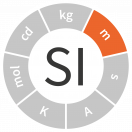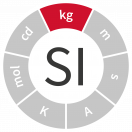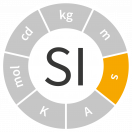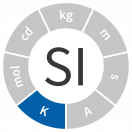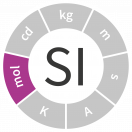
"The SI is a consistent system of units for use in all aspects of life, including international trade, manufacturing, security, health and safety, protection of the environment, and in the basic science that underpins all of these."
Extract from the SI brochure, CIPM Consultative Committee for Units, 9th edition, 2019
The International System of units (SI)
The SI is made up of 7 base units, supplemented by multiple derived quantities.
The system of quantities which underlies the SI and the equations defining the relationships between these quantities are based on the current description of nature and are known to all scientists, technicians and engineers.
The definitions of SI units are established from a set of seven constants of physics. From the fixed values of these seven constants, expressed in SI units, it is possible to deduce all the units of the system. These seven constants are thus the most essential element in the definition of the entire system of units.
The SI's base units
The seven basic quantities are: length, mass, time, electric current, thermodynamic temperature, amount of substance and luminous intensity. The base units are the base on which all the units used to quantitatively express the measured quantities are built. Standards and measurement references are materializations of the measured quantity.
To date, their definitions, are as follows:
The metre
Symbol : m
Quantity : length
Definition : The metre is the SI unit of length. It is defined by taking the fixed numerical value of the speed of light in vacuum c to be 299 792 458 when expressed in the unit m·s−1, where the second is defined in terms of the caesium frequency ΔνCs.
Metre derived units
| Quantity | Unit | Expressed in SI based units |
|---|---|---|
| area | square meter | m2 |
| volume | cubic meter | m3 |
| plane angle | radian (rad) | m.m-1 |
| solid angle | steradian (sr) | m2.m-2 |
| absorbed dose | gray (Gy) | m2.s-2 |
The kilogram
Symbol : kg
Quantity : mass
Definition : The kilogram is the SI unit of mass. It is defined by taking the fixed numerical value of the Planck constant h to be 6.626 070 15 ×10−34 when expressed in the unit J·s, which is equal to kg·m2·s−1, where the metre and the second are defined in terms of c and ΔνCs.
Kilogram derived units
| Quantity | Unit | Expressed in terms of SI based units |
|---|---|---|
| force | newton (N) | m.kg.s-2 |
| pressure | pascal (Pa) | m-1.kg.s-2 |
| electric potential difference | volt (V) | m2.kg.s-3.A-1 |
| energy | joule (J) | m2.kg.s-2 |
| power, radiant flux | watt (W) | m2.kg.s-3 |
The second
Symbol : s
Quantity : time
Definition : The second is the SI unit of time. It is defined by taking the fixed numerical value of the caesium frequency ΔνCs, the unperturbed ground-state hyperfine transition frequency of the caesium 133 atom, to be 9 192 631 770 when expressed in the unit Hz, which is equal to s−1.
Second derived units
| Quantity | Unit | Expressed in terms of SI based units |
|---|---|---|
| frequency | hertz (Hz) | s-1 |
| activity refered to a radionucleide | becquerel (Bq) | s-1 |
| dose equivalent | sievert (Sv) | m2.s-2 |
| absorbed dose | gray (Gy) | m2.s-2 |
The ampere
Symbol : A
Quantity : electric current
Definition : The ampere is the SI unit of electric current. It is defined by taking the fixed numerical value of the elementary charge e to be 1.602 176 634 × 10−19 when expressed in the unit C, which is equal to A·s, where the second is defined in terms of ΔνCs.
Ampere derived units
| Quantity | Unit | Expressed in terms of SI based units |
|---|---|---|
| electric charge | coulomb (C) | s.A |
| electric potential difference | volt (V) | m2.kg.s−3.A−1 |
| electric resistance | ohm (Ω) | m2.kg.s−3.A−2 |
| capacitance | farad (F) | m−2.kg−1.s4.A2 |
| inductance | henry (H) | m2.kg.s−2.A−2 |
| magnetic flux density | tesla (T) | kg.s−2.A−1 |
The kelvin
Symbol : K
Quantity : thermodynamic temperature
Definition : The kelvin is the SI unit of thermodynamic temperature. It is defined by taking the fixed numerical value of the Boltzmann constant k to be 1.380 649 × 10−23 when expressed in the unit J·K−1, which is equal to kg·m2·s−2·K−1, where the kilogram, metre and second are defined in terms of h, c and ΔνCs.
Kelvin derived units
| Quantity | Unit | Expressed in terms of SI based units |
|---|---|---|
|
Celsius temperature t/°C |
degré Celsius (°C) |
K T/K – 273,15 |
| thermal conductivity | watt per metre kelvin | m.kg.s-3.K-1 |
| surface thermal resistance | square-metre kelvin per watt | kg-1.s3.K |
| heat capacity | joule per kelvin | kg.m2.s-2.K-1 |
The mole
Symbol : mol
Quantity : amount of substance
Definition : The mole is the SI unit of amount of substance. One mole contains exactly 6.022 140 76 × 1023 elementary entities. This number is the fixed numerical value of the Avogadro constant, NA, when expressed in the unit mol-1 and is called the Avogadro number.
Mole derived units
| Quantity | Unit | Expressed in terms of SI based units |
|---|---|---|
| molar concentration | mole per cubic metre |
mol.m-3 |
| catalytic activity | katal (kat) | mol.s-1 |
The candela
Symbol : cd
Quantity : luminous intensity
Definition : The candela is the SI unit of luminous intensity in a given direction. It is defined by taking the fixed numerical value of the luminous efficacy of monochromatic radiation of frequency 540 × 1012 Hz, Kcd, to be 683 when expressed in the unit lm·W−1, which is equal to cd·sr·W−1, or cd·sr·kg−1·m−2·s3, where the kilogram, metre and second are defined in terms of h, c and ΔνCs.
Candela derived units
| Quantity | Unit | Expressed in terms of SI based units |
|---|---|---|
| luminous flux | lumen (lm) | cd.sr = m2.m-2.cd |
| illuminance | lux (lx) | lm.m-2 = m-2.cd |
Multiples and sub-multiples
| Factor | Name | Symbol | Factor | Name | Symbol |
|---|---|---|---|---|---|
| 101 | deca | da | 10-1 | deci | d |
| 102 | hecto | h | 10-2 | centi | c |
| 103 | kilo | k | 10-3 | milli | m |
| 106 | mega | M | 10-6 | micro | µ |
| 109 | giga | G | 10-9 | nano | n |
| 1012 | tera | T | 10-12 | pico | p |
| 1015 | peta | P | 10-15 | femto | f |
| 1018 | exa | E | 10-18 | atto | a |
| 1021 | zetta | Z | 10-21 | zepto | z |
| 1024 | yotta | Y | 10-24 | yocto | y |
| 1027 | ronna | R | 10-27 | ronto | r |
| 1030 | quetta | Q | 20-30 | quecto | q |
